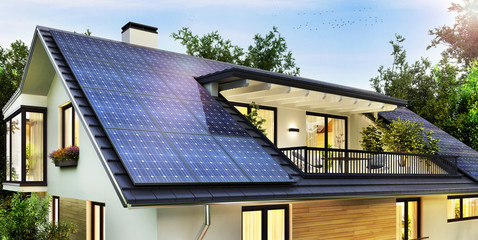The top-rated solar attic fan uses free, renewable energy to push heat out of the attic and reduce your energy bills. It also helps prevent excess heat from leaking into living areas, making your home more comfortable.
This roof-mounted fan is attractive and easy to install. It offers a 48-watt motor that has enough power to exhaust 2,825 square feet of attic space. Read on Radiant Barrier Contractors Houston for tips.
While traditional attic fans require power to operate, solar attic fans use the sun to draw hot air out of your attic space and vent cooler outdoor air into your home. This helps lower your energy bills by reducing the amount of energy needed to cool your home. Because heat rises, it’s important to keep the attic area as cool as possible. Solar attic fans can lower attic temperatures by up to 50 degrees and also help to reduce the buildup of moisture within an attic, which can cause rot and mould.
When properly installed, a solar attic fan can provide your home with 10–12 complete attic ventilation cycles per hour. This can significantly lower cooling costs and improve attic conditions. Since Florida is known for its humidity, it’s essential to control excess moisture in the attic and throughout a home. When left uncontrolled, moisture can lead to mould and mildew, wood rot, and even affect the indoor climate of the home. By keeping the attic dry, a solar attic fan can reduce these issues and extend the life of your roof.
In addition to lowering your cooling costs, a solar attic fan can also make your home more energy-efficient and comfortable year-round. The constant flow of drier, cooler attic air helps to keep the home’s ductwork working more efficiently, lowering the strain on the HVAC system and saving energy in the process.
A solar attic fan can be enhanced with a number of add-ons to increase its efficiency. One such option is the thermal switch, which is designed to activate the fan when attic temperatures reach a certain threshold. Another is the fire safety cutoff switch, which can stop the fan from operating if a fire starts in the attic.
In addition to helping lower the cost of your home’s electricity bills, a solar attic fan can also qualify for a residential energy-efficient property credit. This credit can cover up to 26% of the purchase and installation costs of the solar attic fan. Be sure to check with your local tax authority for more details.
Reduces Condensation
A solar attic fan works all year to reduce the buildup of moisture in your attic and home. Moisture can cause rot, mildew, and mould. It can also lead to damage to insulation and cosmetic issues with the finish of your home’s exterior. Moisture accumulation is especially problematic in newer homes with advanced insulation materials that tend to hold on to more moisture than older homes. A solar attic fan keeps the attic dry by continuously exchanging warm, moist air with cool, drier outdoor air. This prevents condensation from forming and helps maintain an even attic temperature.
The heat and moisture that the solar attic fan expels are replaced by cooler air drawn into the attic through soffit ventilation. Most houses have these vents located along the eaves on the underside of the roof overhang. Typically, you’ll need about eight square feet of soffit vent space for each solar attic fan.
This continuous process of removing heat and moisture is what makes solar attic fans so effective at cooling your home. It reduces the load on your HVAC system during the summer, which in turn lowers your energy bills.
The attic fan is powered by a built-in solar panel, which converts sunlight into electricity to operate the fan. The panels are located on the ridge of the attic, ideally facing south (in the Northern Hemisphere). If your attic is shady or covered with trees, you can add an optional solar panel to the gable vent to make sure your system gets enough sun to operate throughout the day.
A solar attic fan is a powerful, affordable, and environmentally friendly way to help reduce energy costs and improve air quality in your home. It installs easily on top of a gable or other roof penetration, and there are models available for almost any type of roof. You can easily calculate how much a solar attic fan will save you by using the Attic Breeze savings calculator, but keep in mind that the actual amount saved will vary from one house to the next.
Minimizes ice dams
The ice dams that formed on Minnesota roofs two and three winters ago didn’t just look ugly; they were dangerous. Once ice dams form, it’s possible for melted snow to back up underneath roof shingles and leak into the home, damaging walls, ceilings, and insulation. To avoid this costly damage, the key is to prevent ice dams from forming in the first place. That’s why solar attic fans are an excellent choice.
A properly installed solar attic fan and a well-insulated attic will eliminate the main causes of ice dams, which are heat loss from the house to the attic, air leaks around wiring and plumbing in the attic space, and insufficient attic insulation (Lstiburek 2020). A solar attic fan helps address these issues by bringing cool outdoor air into the attic through the intake vents. This airflow flushes out warm attic air and pushes accumulated moisture from the attic through the exhaust vents. The result is that the attic temperature is closer to the ambient attic temperature outside along the entire underside of the roof deck, eliminating the hot and cold spots that invite ice dams.
In addition to proper ventilation and insulation, a well-designed attic system can also be designed to minimize the potential for ice dams by incorporating an unvented roof with an insulated ridge vent or by using a vented roof with a Class II vapour retarder (kraft-faced fibreglass batts, “smart” membrane vapour barrier, or vapour barrier paint) in Climate Zone 6 or higher. Raised-heel energy trusses can also allow the attic floor to be a full thermal zone and help reduce the likelihood of ice dam formation (Lstiburek 2020).
While a solar attic fan is a great solution for preventing ice dams, it’s important to focus on air sealing and insufficient insulation before investing in an attic ventilation system. A solar attic fan is a good option for those who already have a properly insulated attic and proper passive venting, as it will still improve attic air circulation and extend the life of the roof shingles.
Reduces energy bills
Solar attic fans use free, renewable energy from the sun to push hot air out of your home. This lowers your home’s energy bills, reduces your carbon footprint, and helps you stay more comfortable. Unlike traditional attic fans, which are hardwired into your home’s electrical system and require regular maintenance, solar attic fans are simple to maintain, easy to install, and use solar power that is generated from the sun. Solar attic fans are not required to operate on cloudy days and only access the solar power they need on the hottest, sunniest days of the year.
Solar Attic Fan Installation
A properly installed solar attic fan can be operated from sunup to sundown, summer or winter, with no cost for operation. This helps lower your cooling bills by reducing the amount of heat that radiates down into your living spaces, making it easier for your air conditioner to cool the rest of your home. Keeping hot air out of the attic space also prevents attic insulation from degrading and allows for a more efficient home.
Since heat and moisture cause much of the damage to your home, including rot, mould, mildew, frost, and poor indoor air quality, solar attic fans are a great way to reduce these problems. They keep your home cooler and allow your insulation to last longer, which can also save you money on utility bills.
